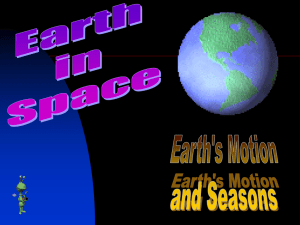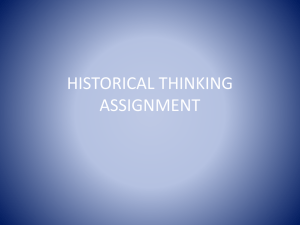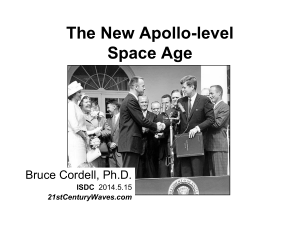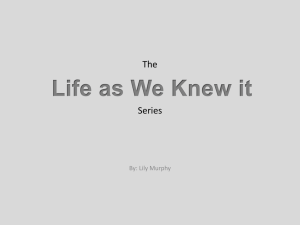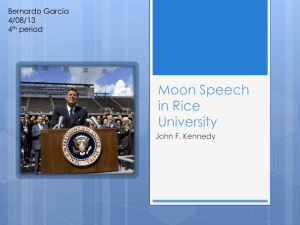Grade 3
advertisement
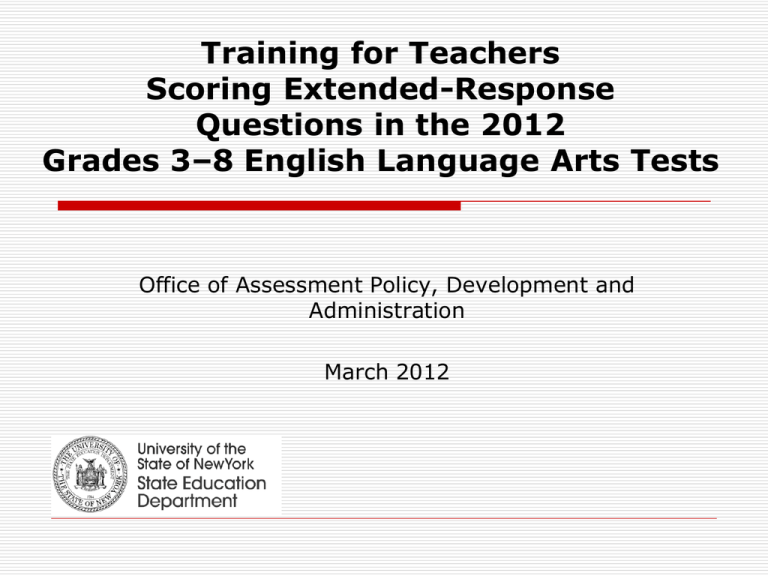
Training for Teachers Scoring Extended-Response Questions in the 2012 Grades 3–8 English Language Arts Tests Office of Assessment Policy, Development and Administration March 2012 Change to the English Language Arts Extended-Response Rubric For 2012, writing mechanics has been added to the rubric for scoring extended responses. Writing mechanics includes the use of spelling, grammar, capitalization, and punctuation and how those attributes assist in communicating the student’s ideas. 2 Examples of Extended–Response Scores The following slides provide an example of an extended response for Grade 3 and for Grade 6 and illustrate how student responses for these tasks will be scored using the revised rubric. 3 Grade 3 Passage Sun Catcher Retold by Pleasant DeSpain Sun Catcher is a legend of the Algonquins, a Native American people. It tells how a great hunter, Tcakabesh, (chu-ka-pech) put out a huge net. The next morning, the sun did not come up. Now read to discover what happened ... Father and son followed the dark trail back to where the sky touches the earth. An enormous and brilliantly bright creature struggled mightily in the net. But it wasn't a large animal held prisoner. It was the sun! “Release me, Hunter!” cried the sun. “I must rise and light the sky.” “Forgive me, Sun,” said Tcakabesh. “The trap wasn’t meant for you. I'll cut you loose.” The hunter tried to get close enough to cut the ropes, but the sun’s heat was too intense, and he was forced to back away. The boy attempted to free the sun. He ran toward the burning orb with his knife held high. He too failed. Tcakabesh called to the forest animals. “I’ve trapped the sun by mistake. Help me free him so that we may have warmth and light once again.” The animals came forth and tried to free the sun. The deer got close, then had to run back. The bear touched the net with his paw and was burned in the attempt. The squirrel jumped toward the sun, and immediately jumped back. The heat was overwhelming. Finally, a brave mouse ran up to the net and quickly nibbled through the ropes with her sharp 4 Grade 3 Passage teeth. The searing heat burned the hair off her back, but she didn't quit until the sun was free. Rapidly rising into the sky, the sun spread light and warmth throughout the land. All the animals and humans breathed a sigh of relief. Ever since that time, the sun has stayed away from the place where the sky touches the earth. When asked why, he says, “Because Tcakabesh is too good a trapper.” Ever since that time, the mouse has had short hair on its back. The mouse reminds us that sometimes, when the biggest fail, it is the smallest that succeed. 5 Grade 3 Question 6 Grade 3 Question (continued) 7 REVISED English Language Arts Extended–Response Rubric Grade 3 3 points __________________________________________________ The response: • Fulfills the requirements of the task • May use sentence variety and some challenging vocabulary • Makes effective use of relevant and accurate details from the text • Demonstrates a thorough understanding of the text • Establishes and maintains a clear focus • Is fluent and easy to read and may display a sense of engagement or voice • Uses spelling, grammar, capitalization, and punctuation in a manner that assists considerably in communicating the student’s ideas 8 REVISED English Language Arts Extended–Response Rubric Grade 3 2 points ___________________________________________ The response: • Fulfills some requirements of the task • Uses only simple sentences, some sentence fragments, and grade-level vocabulary • Provides some relevant details from the text, which may include minor inaccuracies • Demonstrates a predominantly literal understanding of the text • Is generally focused • Is readable and may display some sense of engagement or voice • Uses spelling, grammar, capitalization, and punctuation in a manner that adequately aids in communicating the student’s ideas 9 REVISED English Language Arts Extended–Response Rubric Grade 3 1 point ________________________________________ The response: • Fulfills few requirements of the task • Uses sentence fragments or word phrases with belowgrade-level vocabulary • Provides a general knowledge of the text or no specific details • Demonstrates some misunderstandings or gaps in understanding the text • Lacks focus • Is difficult to read and has little or no sense of engagement or voice • Uses spelling, grammar, capitalization, and punctuation in a manner that impedes understanding of the student’s ideas 10 English Language Arts ExtendedResponse Rubric Grade 3 0 points __________________________________________________ • The response is irrelevant, incoherent, incorrect, or illegible. 11 Anchor Set Papers & Annotations Review each annotation. anchor paper and the corresponding 12 Anchor Paper – Score Point 3 13 Anchor Paper – Score Point 3 (continued) 14 Anchor – Score Point 3 This response fulfills the requirements of the task. The response attempts to use sentence variety and some challenging vocabulary. The response makes effective use of relevant and accurate details from the text to support the answer (the boy caught the sun, and in real life no one can catch the Sun). The response demonstrates a thorough understanding of the text (The animals tried to free the Sun . . . but that could not happen in real life and the Sun can’t be caught. The sun is not a he or a She). The response maintains a clear focus. The response displays a sense of voice (That is one hot Sun). The response uses spelling, grammar, and capitalization in a manner that assists considerably in communicating the student’s ideas, although it is somewhat weaker in the use of punctuation. 15 Anchor Paper – Score Point 2 16 Anchor – Score Point 2 This response fulfills some requirements of the task. The response provides some relevant details from the text to support the answer (mice cannot talk and the sun can’t be on earth because everything would be destroyed). The response demonstrates a literal understanding of the text (there can’t be . . . a sun catcher because nobody could catch the sun . . . too big and hot to get cought). The response displays some sense of engagement (you have to go to space to catch the sun). The response uses spelling, grammar, and punctuation in a manner that adequately aids in communicating the student’s ideas, although it is weaker in the use of capitalization. 17 Anchor Paper – Score Point 1 18 Anchor – Score Point 1 This response fulfills few requirements of the task. The response provides a general knowledge of the text with some gaps in understanding (animals can’t talk and the sun can’t get trap ped and animals would not save it). The response is difficult to read and there is no sense of voice. The response uses spelling, grammar, capitalization, and punctuation in a manner that impedes understanding of the student’s ideas (This not true and What the character that not true). 19 Anchor Paper– Score Point 0 20 Anchor – Score Point 0 This response is irrelevant because it is only a summary of the story. The response does not fulfill any of the requirements of the task. 21 Grade 3: Practice Set Papers Rate each practice paper individually and then review annotations for each response. 22 Grade 3: Practice Set Paper A 23 Grade 3: Practice Set Paper B 24 Grade 3: Practice Set Paper C 25 Grade 3: Practice Set Paper C (continued) 26 Grade 3: Practice Set Paper D 27 Grade 3: Practice Set Paper E 28 Grade 3: Practice Set Paper F 29 Grade 3: Practice Set Paper G 30 Grade 3: Practice Set Paper G (continued) 31 Grade 3: Practice Set Annotations Share scores and discuss 32 Grade 3: Practice Paper A - Score Point 1 This response fulfills few requirements of the task. The response provides a general knowledge of the text with some gaps in understanding. The response provides one reason why the story could not happen in real life but provides no details from the text (The Sun cannot be cot in a net). There is no sense of engagement or voice. The response uses spelling and punctuation in a manner that impedes understanding of the student’s ideas (cot). 33 Grade 3: Practice Paper B - Score Point 0 This response is irrelevant because it is only a summary of the story. The response does not fulfill any of the requirements of the task. 34 Grade 3: Practice Paper C - Score Point 3 This response fulfills the requirements of the task. The response uses sentence variety and some challenging vocabulary. The response makes effective use of relevant and accurate details from the text to support the answer (Nobody can catch the sun! No one can go so near the sun that they get burned!). The response demonstrates a thorough understanding of the text (No animal can reach up to the sun. Besides, there is not one net so powerful, that it can’t be burned by the sun). The response maintains a clear focus. The response displays a sense of voice (Why would it be possible for the sun to burn creatures smaller than us?). The response uses spelling, grammar, capitalization, and punctuation in a manner that assists considerably in communicating the student’s ideas. 35 Grade 3: Practice Paper D - Score Point 2 This response fulfills some requirements of the task. The response provides some relevant details from the text to support the answer (Every reader knows that no thing even nobody can trap the sun because the sun would just burn up the trap). The response demonstrates a predominantly literal understanding of the text (when the mouse ran in to the trap to free the sun he wouldn’t be still living). The response is generally focused and displays some sense of voice (This story is not true!). The response uses spelling, capitalization, and punctuation in a manner that adequately aids in communicating the student’s ideas, although it is weaker in the use of grammar (knows that no thing even nobody). 36 Grade 3: Practice Paper E - Score Point 1 This response fulfills few requirements of the task. The response uses a run-on sentence. The response provides a general knowledge of the text with some gaps in understanding (In the story Sun catcher what is possible that can happen in real life is the sun gitting cappered by a boy in a rope). The response is difficult to read and displays no sense of voice. The response uses grammar, capitalization, and punctuation in a manner that impedes understanding of the student’s ideas (there are talking animals in the story so it is a non-fiction story the stuff in the story is fake it is not real). 37 Grade 3: Practice Paper F - Score Point 2 This response fulfills some requirements of the task. The response provides some relevant details from the text to support the answer (The reader knows that the sun can not be trapped by this guy named Tcakabesh). The response demonstrates a literal understanding of the text (The Characters can not free the sun in real life because if you did you would burn into ashes). The response is generally focused. The response displays some sense of voice (All of the characters . . . die if they were about 1-10 feet away). The response uses spelling, capitalization, and punctuation in a manner that adequately aids in communicating the student’s ideas, although it is weaker in the use of grammar (burn into ashes and be died and all of the ropes of). 38 Grade 3: Practice Paper G - Score Point 3 This response fulfills the requirements of the task. The response uses sentence variety and some challenging vocabulary. The response makes effective use of relevant and accurate details from the text to support the answer (nobody can catch the sun because the sun is in space . . . you cant catch the sun not even walk on the sun its way to hot to do that!). The response demonstrates a thorough understanding of the text (Characters would not be able to touch the sun they would melt in three seconds!). The response maintains a clear focus. The response displays a sense of voice. The response uses spelling, grammar, and capitalization in a manner that assists in communicating the student’s ideas, although it is weaker in punctuation (cant and its way). 39 Grade 6 Passages How the Sun and the Moon Came to Live in the Sky A Nigerian Folktale Retold by Adrienne Farrell Long, long ago, the Sun and the Water were the very best of friends. Both lived happily on the earth as neighbors. The Sun often visited his friend the Water. He felt quite welcome at his friend's home. However, the Sun was troubled that his friend never visited him in return. The Sun wondered and worried and worried and wondered until his wife, the Moon, asked what was troubling him. When the Sun told the Moon his complaint against his friend, the Moon had a ready answer: “Go and ask him yourself, then,” she said. When he saw the Sun, the Water welcomed his friend, and the two entered the Water’s house and sat down to chat. They talked of this and that, and of many other things. At last, the Sun brought up the matter that bothered him so much. “0, my friend,” said the Sun. “Why is it that I visit you in your home and you never fail to welcome me, but you never come to my house to visit?” The Water laughed a long laugh, a laugh that bubbled like the sound of river flowing over rocks. “Have you noticed how large I am?” The Water waved his watery arms. A couple of drops splashed onto the Sun's face. “Have you noticed the people and animals who follow me everywhere I go?” Only then did the Sun notice the rivers and the creeks and the brooks and the lakes and the ponds. Only then did the Sun notice all the fish and all the creatures. “If I visited you now, we would drive you out of your house,” said the Water. “I will visit 40 Grade 6 Passages you, though, if you build a place large enough for all of us.” The Sun went home and told the Moon his plan. Then he started to work. He worked all day and all night for weeks. At last, he was finished. The Sun went to the Water and asked his friend to come and visit the next day. The Water agreed. The next day, the Water arrived at the Sun’s door. The Water asked if it was safe for him to enter. “0, yes, my friend,” said the Sun. “Come in. Come in, and bring your friends.” The Water began to flow into the Sun’s house. Along with the Water came all the fish and all the creatures that lived with the Water. Along with all the fish and creatures came all the rivers and creeks and brooks and lakes and ponds. Soon, the Water covered the entire floor of the house. The Water asked if it was still safe, for there were more of his people outside. The Sun invited him to bring his people inside. More of the Water’s people and fish and creatures entered. The flood rose as high as all the windows. Then it rose nearly to the roof. The Sun and the Moon found themselves on top of the roof, and still the Water flowed in. To keep from floating away, the Sun threw a ladder up to the sky. The Sun and the Moon climbed the ladder and perched up in the sky. This is where they have stayed ever since. 41 Grade 6 Passages Shedding Light on the Sun and the Moon The Sun and the Moon have always fascinated humankind. Cultures all across the globe have looked to the skies in awe of these two beautifully glowing objects. Thanks to modem technology, we know much more about the Sun and Moon than our ancestors did. The Sun The Sun is a star, much like any other star in the universe. The Sun, however, is the most important star to people on Earth because without it, nothing could survive. For years, scientists have studied the Sun and discovered many interesting facts. The Sun is about 93 million miles away from Earth. To get an idea of how far away that is, imagine taking a trip from Lake Placid, in the northern part of New York State, to New York City, in the southern part, roughly 382,716 times. If that trip was taken one time each day, it would still take more than 1,000 years before enough miles were covered to represent the distance from Earth to the Sun! Even at that great distance, however, the light from the Sun reaches Earth very quickly. Cruising at a speed of about 186,000 miles per second, the light from the Sun takes only a little more than eight minutes to reach Earth. (The time it takes sunlight to travel from Lake Placid to New York City is faster than the blink of a human eye!) Without heat from the Sun, everything on Earth would freeze. In order to provide enough heat for Earth, the Sun would have to be big. And big it is! The radius of the Sun is 109 times 42 Grade 6 Passages larger than the radius of Earth. How hot is the Sun? That depends on which part of the Sun the temperature is taken. Like Earth, the Sun has layers. The surface of the Sun is around 9,944 to 10,292 degrees Fahrenheit, but the core is much hotter. The core of the Sun is estimated to reach temperatures of more than 27 million degrees Fahrenheit. The Moon Humans have always wondered about the Moon. Perhaps this is because the Moon is Earth’s closest neighbor. While some other planets have many moons orbiting them, the Earth's Moon is its only natural satellite. The Moon has no light that it produces on its own. It simply reflects the light from the Sun. One side of the Moon continually faces Earth. The light reflecting off this side of the Moon has allowed people to study the Moon for thousands of years. Galileo used a telescope to view the Moon and recorded what he saw—a rough surface with what looked to be mountains. The idea that the Moon may have mountains on it captured Galileo’s imagination. He also described a large crater on the Moon. Soon, theories and debates began about how this crater could have formed. Scientists now know that there are many craters on the Moon. They believe that the craters were formed from meteorites, asteroids, and comets crashing into the Moon’s surface. Many of these craters are more than twenty-five miles across. The largest crater is 1,300 miles across. That is about the same distance as from Albany, New York, to Oklahoma City, Oklahoma! One of the most interesting facts about the Moon is the amount of gravitational pull it has compared to Earth's gravity. Gravity on the Moon is about 1/6 that of Earth. That means that a person weighing 150 pounds on Earth would only weigh about 25 pounds on the Moon. 43 Grade 6 Passages Like Earth, the Moon is made up of three layers: the crust, the mantle, and the core. But unlike Earth, the Moon's temperature varies greatly from -280 degrees Fahrenheit at night to 260 degrees Fahrenheit in the daytime. The Moon has one more characteristic that sets it apart from any other celestial body in the universe. On July 20, 1969, it became the only other place besides Earth where humans have walked. On that day, Neil Armstrong became the first human in history to walk upon the surface of the Moon. Both the Sun and the Moon continue to inspire people to study about them. Scientists want to learn all they can about these two places, because by learning about the Sun and the Moon, we will discover more about other places in the universe. 44 Grade 6 Question 45 Grade 6 Question 46 REVISED English Language Arts Extended–Response Reading Rubric Grades 4–8 4 points __________________________________________________ The response: • Fulfills the requirements of the task • Uses sentence variety, with some challenging vocabulary • Makes effective use of relevant and accurate details from the texts • Demonstrates a thorough understanding of the texts • May demonstrate inferences from the texts and maintains a clear focus • Is fluent and easy to read and displays a sense of engagement or voice • Uses spelling, grammar, capitalization, and punctuation in a manner that assists considerably in communicating the student’s ideas 47 REVISED English Language Arts Extended–Response Reading Rubric Grades 4–8 3 points ___________________________________________ The response: • Fulfills the requirements of the task • Uses simple sentences with grade-level vocabulary • Uses relevant and accurate details from the texts • Demonstrates a predominantly literal understanding of the texts • Maintains a predominantly clear focus • Is fluent and easy to read and may display a sense of engagement or voice • Uses spelling, grammar, capitalization, and punctuation in a manner that adequately aids in communicating the student’s ideas 48 REVISED English Language Arts Extended–Response Reading Rubric Grades 4–8 2 points __________________________________________________ The response: • Fulfills some requirements of the task • Uses predominantly simple sentences, some sentence fragments, and grade-level vocabulary • May use some relevant and accurate details from the texts • May demonstrate some misunderstandings or gaps in understanding of the texts • Attempts to maintain or establish a clear focus • May be somewhat difficult to read, contains some inaccuracies, and displays no sense of engagement or voice • Uses spelling, grammar, capitalization, and punctuation in a manner that may impede understanding of the student’s ideas 49 REVISED English Language Arts Extended–Response Reading Rubric Grades 4–8 1 point ___________________________________________ The response: • Fulfills few requirements of the task • Uses sentence fragments or word phrases with belowgrade-level vocabulary • May use no details or irrelevant details to support the response • May demonstrate very little understanding of the texts • Does not establish a clear focus • May be difficult to read, contains many inaccuracies, and displays no sense of engagement or voice • Uses spelling, grammar, capitalization, and punctuation in a manner that impedes understanding of the student’s ideas 50 English Language Arts ExtendedResponse Reading Rubric Grades 4–8 0 points __________________________________________________ • The response is irrelevant, incoherent, incorrect, or illegible. 51 Anchor Set Papers & Annotations Review each anchor paper and annotation 52 Anchor Paper– Score Point 4 53 Anchor Paper– Score Point 4 (continued) 54 Anchor – Score Point 4 This response fulfills the requirements of the task. The response uses sentence variety (Unlike the Sun, the Moon cannot create light/solar energy). The response makes effective use of relevant and accurate details to support the answer (On the surface of the Sun, the heat is about 9,944 to 10,292 degrees farenheight; the Moon is made up of layers; the Moon reaches temperatures of 260 degrees farenheight; the Sun is described as friendly and welcoming to his best friend the Water. His wife, the Moon, has a very helpful character to her husband). The response demonstrates a thorough understanding of the texts [because none of the characters (the Sun, Moon, and Water) cannot talk or move like human beings. They also can’t build houses or “be married”]. The response provides inferences from the texts and maintains a clear focus. The response displays a sense of voice (Have you ever looked up at the stars at night and wondered about the extra terrestrio life in the solar system?). The response uses spelling, grammar, capitalization, and punctuation in a manner that assists considerably in communicating the student’s ideas. 55 Anchor Paper– Score Point 3 56 Anchor Paper– Score Point 3 (continued) 57 Anchor – Score Point 3 This response fulfills the requirements of the task. The response uses simple sentences with grade-level vocabulary (The sun was persistant). The response uses relevant and accurate details from the texts as support for the answer [the Sun was friends with water; The Moon (Suns wife) gave good but not great ideas; 1. The Sun is more than 27 million degrees Fahrenheit. 2. The moon gets its glow from the sun behind it. 3. The moon 1/6 the gravity of the Earth]. The response demonstrates a predominantly literal understanding of the texts (The folktale would have to take out them talking). The response maintains a predominantly clear focus. The response is fluent and easy to read with a sense of voice (The water just went with the flow). The response uses spelling, grammar, capitalization, and punctuation in a manner that adequately aids in communicating the student’s ideas. 58 Anchor Paper– Score Point 2 59 Anchor – Score Point 2 This response fulfills some requirements of the task. The response uses predominantly simple sentences (The sun is fire). The response uses some relevant and accurate details from the texts to support the answer (We can not land on the sun because it is to hot. The sun gives us heat. Earth has more gravite then the moon. If we don’t ware a sout on the moon we can flout away. Another fact about the moon is that the moon has layers). The response does not address the characteristics of the Sun and the Moon. The response demonstrates some misunderstanding of the texts (it would stay in one place and it would be very cold all the time). The response attempts to maintain a clear focus. The response displays no sense of voice. The response uses spelling in a manner that may impede understanding of the student’s ideas (gravite, sout, ware, flout). 60 Anchor Paper– Score Point 1 61 Anchor – Score Point 1 This response fulfills few requirements of the task. The response provides one text-based detail to support a characteristic of the Sun (One character trait is the sun is vary freindly). The response does not address characteristics of the Moon, and the attempt to provide a fact about the Sun and the Moon is general (they are large). The response demonstrates very little understanding of the texts. The response does not establish a clear focus and has no sense of voice. The response uses spelling in a manner that may impede understanding of the student’s ideas (vary freindly). 62 Anchor Paper– Score Point 0 63 Anchor – Score Point 0 This response is irrelevant. The response does not fulfill any of the requirements of the task. The details given are not text-based and do not address the prompt (Its like a cartoon, Is like real life, I think the moon is getting enoryed by her husband). 64 Grade 6: Practice Set Papers Rate each practice paper individually and then review annotations for each response. 65 Grade 6: Practice Set Paper A 66 Grade 6: Practice Set Paper A (continued) 67 Grade 6: Practice Set Paper B 68 Grade 6: Practice Set Paper C 69 Grade 6: Practice Set Paper C (continued) 70 Grade 6: Practice Set Paper D 71 Grade 6: Practice Set Paper E 72 Grade 6: Practice Set Paper F 73 Grade 6: Practice Set Paper G 74 Grade 6: Practice Set Paper G (continued) 75 Grade 6: Practice Set Paper H 76 Grade 6: Practice Set Paper I 77 Grade 6: Practice Set Paper I (continued) 78 Grade 6: Practice Set Annotations Share scores and discuss 79 Grade 6: Practice Paper A - Score Point 2 This response fulfills some requirements of the task. The response uses predominantly simple sentences (The sun give heat then In the night the the sun give the moon light). The response uses some relevant and accurate details from the texts to support the answer (It say the sun travel’s to eart qucker than a space rocket it travel to earth about 186,000 miles). The response demonstrates some misunderstanding of the texts. The response attempts to maintain a clear focus. The response is somewhat difficult to read and displays no sense of voice. The response uses spelling, grammar, and capitalization in a manner that may impede understanding of the student’s ideas (In The story the sun and the moon It say the sun, eart, qucker). 80 Grade 6: Practice Paper B - Score Point 1 This response fulfills few of the requirements of the task. The response uses few details from the texts to support the answer (Sun has light. Moon has No light). The response does not address the character traits. The response demonstrates little understanding of the texts (could not talk). The response is somewhat difficult to read. The response uses spelling, grammar, capitalization, and punctuation in a manner that may impede understanding of the student’s ideas (The sun and moon came to The sky because so they can always see each other and latter). 81 Grade 6: Practice Paper C - Score Point 4 The response fulfills the requirements of the task. The response uses sentence variety. The response makes effective use of relevant and accurate details from the texts to support the answer (the Sun is nice and thoughtful, The water is thoughtful to, she goes along with the Sun’s plan, The moon has many craters, also the Sun is further away from the earth than the moon). The response demonstrates a thorough understanding of the texts (the sun would have climed the latter relly far because the sun is 93 mill. Miles from the earth). The response demonstrates inferences from the texts (The moon and the sun are both huge parts of human life) and maintains a clear focus. The response is fluent, easy to read, and displays a sense of voice (Are you fasinated about the moon and the sun?). The response uses grammar and capitalization in a manner that assists considerably in communicating the student’s ideas, although it is weaker in the use of spelling and punctuation (climed, latter, relly). 82 Grade 6: Practice Paper D – Score Point 0 This response is irrelevant. It does not fulfill any of the requirements of the task. The details given do not address the prompt. 83 Grade 6: Practice Paper E - Score Point 3 This response fulfills the requirements of the task. The response uses simple sentences (The moon is caring for the sun). The response uses relevant and accurate details from the texts to support the answer (The Sun is friendly and caring. The moon is caring for the sun; The sun creates light; People have walked on the Moon). The response demonstrates a predominantly literal understanding of the texts (The Sun, Moon, or Water talking and The Sun would not have Built a house). The response maintains a predominantly clear focus. The response is fluent and easy to read. The response uses spelling, capitalization, and punctuation in a manner that adequately aids in communicating the student’s ideas, although it is weaker in the use of grammar. 84 Grade 6: Practice Paper F - Score Point 2 This response fulfills some requirements of the task. The response provides some text-based details to support the answer (they both lived happily on Earth as neighbors; people are really intrested about them; have a core, a mantle, and a crus; the Moon is Earth’s closest neighbor). The response demonstrates gaps in understanding the texts. The response attempts to maintain a clear focus (The character traits and The three facts). The response is somewhat difficult to read and displays no sense of voice. The response uses punctuation in a manner that may impede understanding of the student’s ideas (the moon are, people). 85 Grade 6: Practice Paper G - Score Point 4 The response fulfills the requirements of the task. The response uses sentence variety. The response uses relevant and accurate details from the texts to support the answer (The Sun is determined, The Moon is prepared, The Sun is 93 million miles away from Earth). The response demonstrates a thorough understanding of the texts (The Water would evaporate in two seconds. With a temperature that hot, the sun can’t come with in two inches with water). The response maintains a clear focus. The response is fluent, easy to read, and displays a sense of voice (Do you know any other facts; Don’t make that mistake Sun; Remember, these traits are from a folktale, not a non-fiction book). The response uses spelling, grammar, capitalization, and punctuation in a manner that assists considerably in communicating the student’s ideas. 86 Grade 6: Practice Paper H - Score Point 1 This response fulfills few of the requirements of the task. The response uses a sentence fragment (Some facts from shedding light on the Sun). The response provides few text-based details to support the answer (smart and thoughtful; worried, happy, and welcoming; welcoming, liked, and joyful). The response demonstrates very little understanding of the texts. The response displays no sense of voice. The response uses grammar and punctuation in a manner that impedes understanding of the student’s ideas. 87 Grade 6: Practice Paper I – Score Point 3 This response fulfills the requirements of the task. The response uses simple sentences with grade-level vocabulary. The response uses relevant and accurate details from the texts to support the answer (the Sun was very whiney; the Moon was very calm; the Sun was careless; One, the sun is the most important star; Lastly, the sun is 93 million miles away from the earth). The response demonstrates a predominantly literal understanding of the texts (the Sun and Moon in real life don’t talk. Second, water that big can’t travel). The response maintains a predominantly clear focus (some character traits, One, Another trait). The response is fluent and easy to read. The response uses spelling, grammar, capitalization, and punctuation in a manner that adequately aids in communicating the student’s ideas. 88
